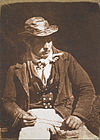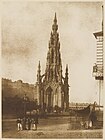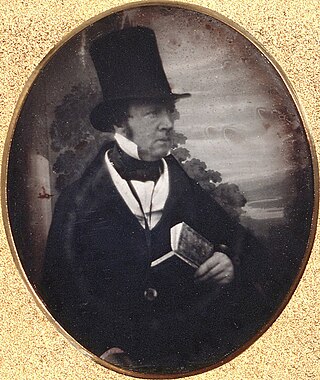
William Henry Fox Talbot FRS FRSE FRAS was an English scientist, inventor, and photography pioneer who invented the salted paper and calotype processes, precursors to photographic processes of the later 19th and 20th centuries. His work in the 1840s on photomechanical reproduction led to the creation of the photoglyphic engraving process, the precursor to photogravure. He was the holder of a controversial patent that affected the early development of commercial photography in Britain. He was also a noted photographer who contributed to the development of photography as an artistic medium. He published The Pencil of Nature (1844–1846), which was illustrated with original salted paper prints from his calotype negatives and made some important early photographs of Oxford, Paris, Reading, and York.
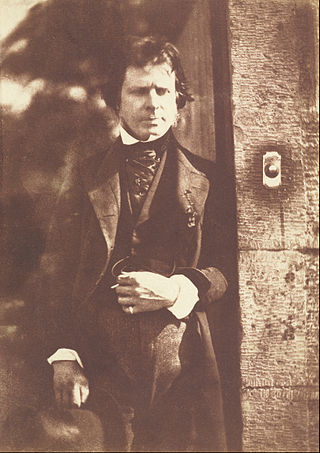
David Octavius Hill was a Scottish painter, photographer and arts activist. He formed Hill & Adamson studio with the engineer and photographer Robert Adamson between 1843 and 1847 to pioneer many aspects of photography in Scotland.

Robert Adamson was a Scottish chemist and pioneer photographer at Hill & Adamson. He is best known for his pioneering photographic work with David Octavius Hill and producing some 2500 calotypes, mostly portraits, within 5 years after being hired by Hill in 1843.

Alexander Boyd FRSA is a Scottish artist and photographer.
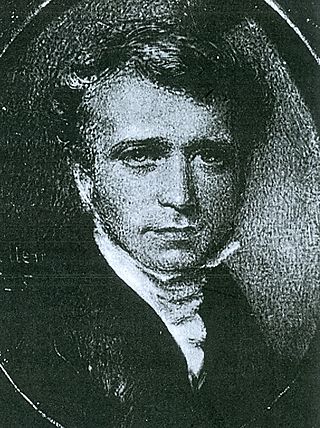
Henry Collen was an English miniature portrait painter to Queen Victoria of the United Kingdom and the Duchess of Kent. Later in life he turned to photography and was the first professional calotypist in London.

Thomas Annan (1829–1887) was a Scottish photographer, notable for being the first to record the bad housing conditions of the poor.

The Edinburgh Calotype Club of Scotland was the first photographic club in the world. Its members consisted of pioneering photographers primarily from Edinburgh and St Andrews. The efforts of the Club's members resulted in the production of two of the world's earliest assembled photographic albums, consisting of more than 300 images.
The David Octavius Hill Medal is a prize in photography established in 1955, by the Deutsche Fotografische Akademie. It is named in honor of the Scottish artist David Octavius Hill, famous for his Hill & Adamson calotypes, most of which were developed at Adamson's studio, the "Rock House", on Calton Hill in Edinburgh.
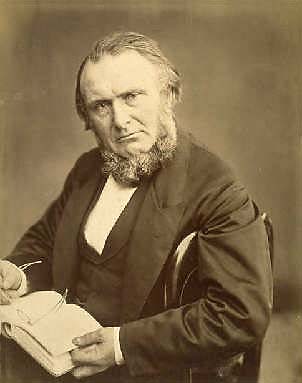
John Adamson was a Scottish physician, pioneer photographer, physicist, lecturer and museum curator. He was a highly respected figure in St Andrews, and was responsible for producing the first calotype portrait in Scotland in 1841. He taught the process to his brother, the famous pioneering photographer Robert Adamson. He was curator of the Literary and Philosophical Society Museum at St Andrews from 1838 until his death.

Thomas Rodger was an early Scottish photographer. He studied at the University of St Andrews and was a protégé of Dr. John Adamson who also persuaded him to become a photographer. At age 14, he was apprenticed to Dr. James, a local chemist and druggist, whilst studying at Madras College. Adamson later taught him the calotype process which he had earlier taught his famous brother, Robert Adamson. Adamson persuaded him to assist Lord Kinnaird in his calotype studio at Rossie Priory. Rodger enrolled at the Andersonian College of Glasgow to study medicine, but Adamson persuaded him to set up a professional business in calotyping in St Andrews.

Scottish art in the nineteenth century is the body of visual art made in Scotland, by Scots, or about Scottish subjects. This period saw the increasing professionalisation and organisation of art in Scotland. Major institutions founded in this period included the Institution for the Encouragement of the Fine Arts in Scotland, the Royal Scottish Academy of Art, the National Gallery of Scotland, the Scottish National Portrait Gallery and the Glasgow Institute. Art education in Edinburgh focused on the Trustees Drawing Academy of Edinburgh. Glasgow School of Art was founded in 1845 and Grays School of Art in Aberdeen in 1885.

Patric Park was a Scottish sculptor.
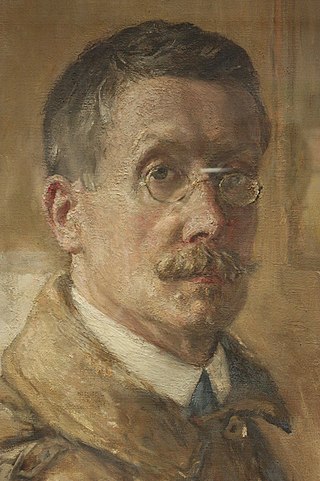
Alexander Ignatius Roche RSA NEAC RP was a Scottish artist in the late 19th century and an important figure in the "Glasgow Boys".
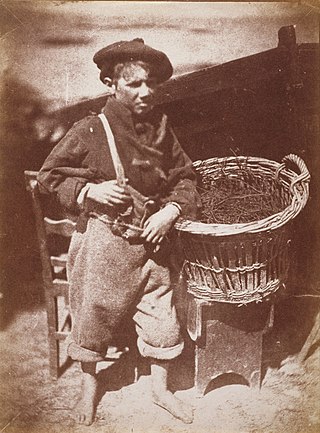
Scotland played a major role in the technical development of photography in the nineteenth century through the efforts of figures including James Clerk Maxwell and David Brewster. Its artistic development was pioneered by Robert Adamson and artist David Octavius Hill, whose work is considered to be some of the first and finest artistic uses of photography. Thomas Roger was one of the first commercial photographers. Thomas Keith was one of the first architectural photographers. George Washington Wilson pioneered instant photography and landscape photography. Clementina Hawarden and Mary Jane Matherson were amongst the first female photographers. War photography was pioneered by James MacCosh, James Robertson, Alexander Graham and Mairi Chisholm.
John McCosh or John MacCosh or James McCosh was a Scottish army surgeon who made documentary photographs whilst serving in India and Burma. His photographs during the Second Anglo-Sikh War (1848–1849) of people and places associated with the British rule in India, and of the Second Burmese War (1852–1853), count as sufficient grounds, some historians maintain, to recognise him as the first war photographer known by name. McCosh wrote a number of books on medicine and photography, as well as books of poetry.

Archibald Burns (1831–1880) was a Scottish photographer based in Edinburgh, Scotland, and active from 1858 to 1880. He documented the city through various publications and recorded the historic buildings in a section of the city that was cleared for improvements in the 1860s.

John Lidell Cay FRSE PRSSA was a Scottish advocate, pioneer photographer and antiquarian. He served as the Sheriff of Linlithgowshire 1822–65. He was the maternal uncle of James Clerk Maxwell.

Janet Mann(Jessie) (20 January 1805 – 21 April 1867) was the studio assistant of the pioneering Scottish photographers David Octavius Hill and Robert Adamson. She is "a strong candidate as the first Scottish woman photographer" and one of the first women anywhere to be involved in photography.
Cornelius Jabez Hughes was a British photographer, daguerreotypist, and writer. He was one of the best known portrait photographers in Victorian England, and today his photographs are included in a number of notable museum collections including the National Portrait Gallery in London and The J. Paul Getty Museum in Los Angeles.
Craig Easton is a British photographer who lives in The Wirral and works on long-term social documentary projects that deal with the representation of communities in the North of England. He has made work about women working in the UK fish processing industry; about the inter-generational nature of poverty and economic hardship in Northern England; about social deprivation, housing, unemployment and immigration in Blackburn; and about how the situation in which young people throughout the UK live, influences their aspirations.



